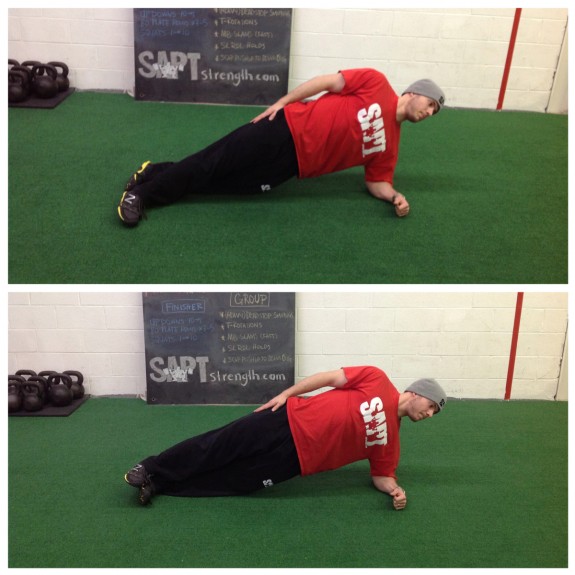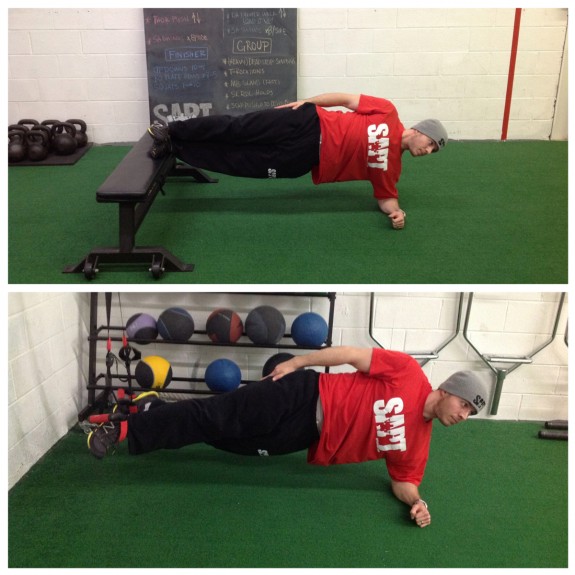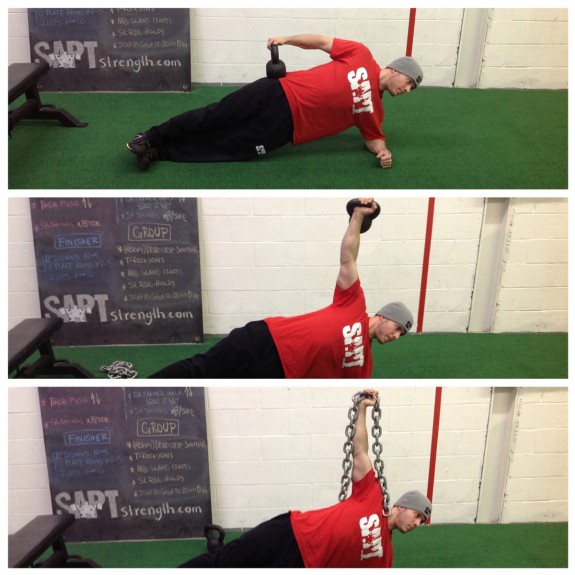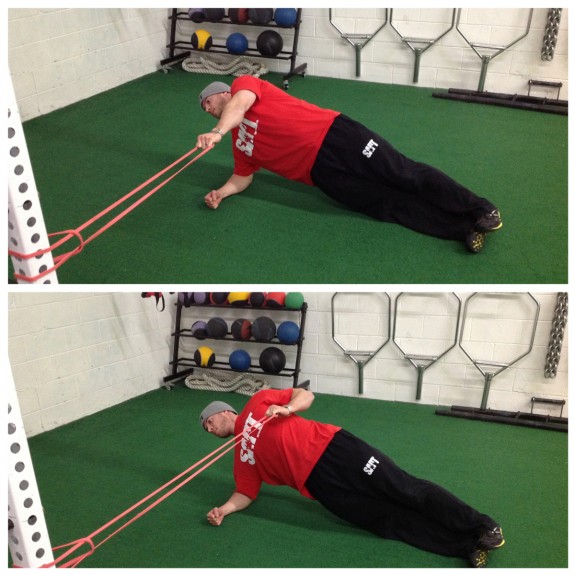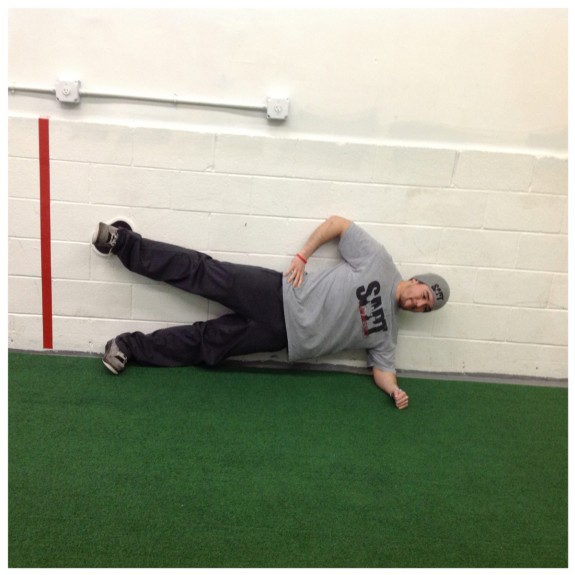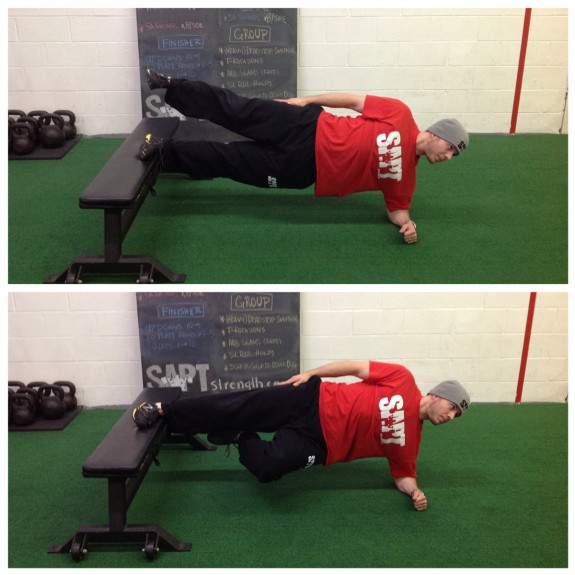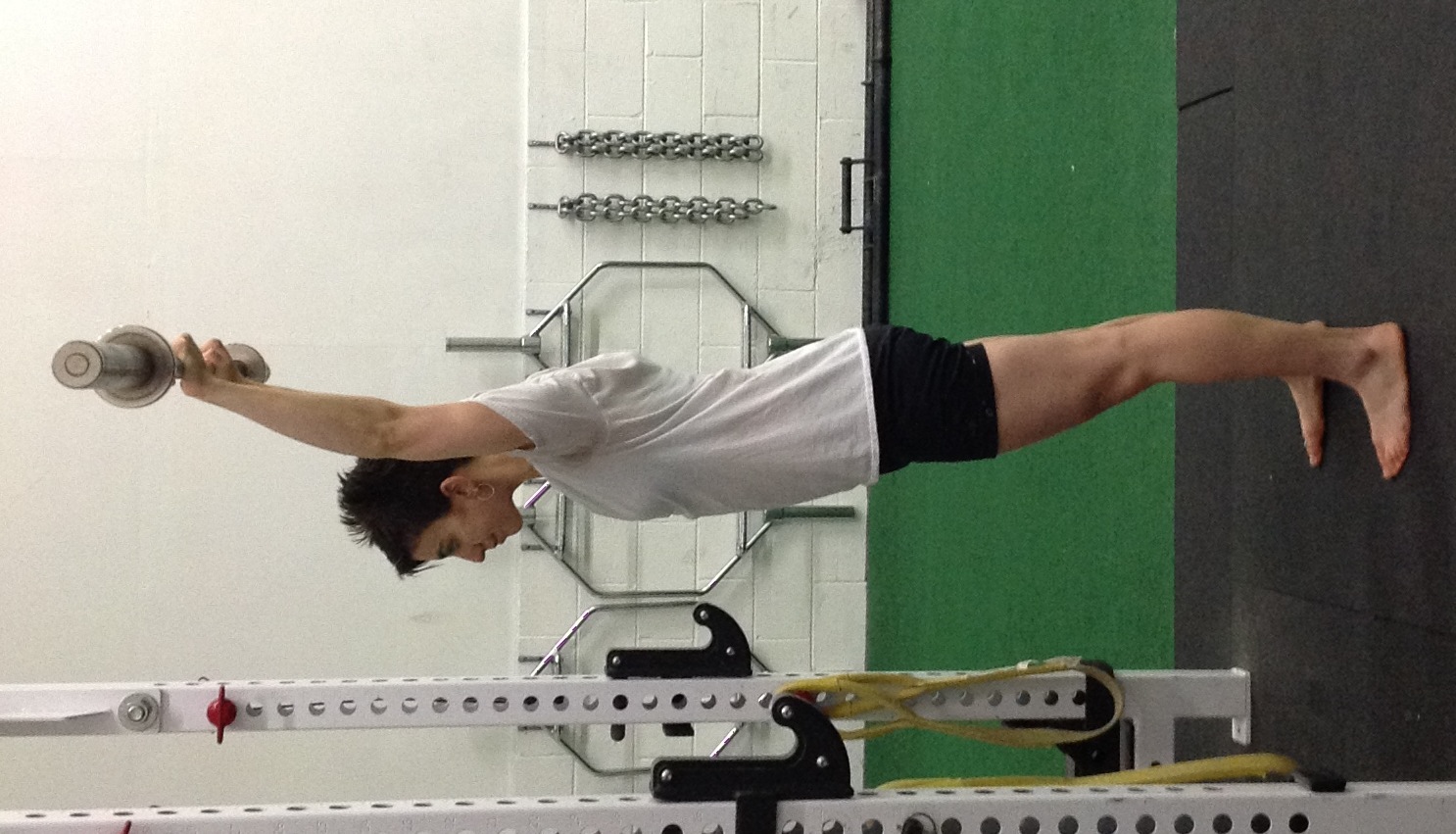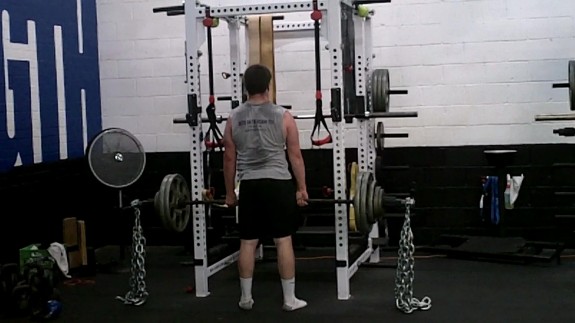How to Warm-Up in a Hurry: Lower Body Edition
Ever find yourself in a time crunch where have to "get in, get out" of the gym quickly and efficiently?
Yeah, me too. Probably more than I'd like.
Those of us enlightened folk know that a proper warm-up - consisting of self-myofascial release, dynamic flexibility and mobility work, along with a few acute corrective drills, to name a few - goes a long way toward ensuring a higher-performing body and stronger lifts.
But if you're crunched for time, how do you prepare?
Do you spend thirty minutes on foam rolling, glute bridging and spiderman-ing (yeah, I made that last one up), only to leave a mere five minutes for strength training?
Or, do you just hop under the bar and start squatting it like there's no tomorrow?
Do you skip the weight room altogether?
None of the above is ideal, so I thought I'd lay out what I personally do before a lower-body-focused session when pressed for time. In fact, after performing the warm-up I'm about to share, I've had some of the best training sessions of my life.
Enter the most economical warm-up you've ever seen:
1. Pushup to Yoga Stretch Complex
Note: I usually go 10 pushups --> 5 Downward Dog --> 2 Spiderman to Glute Mob/side
2. Walking Knee Hug to Warrior Lunge Stretch (x5/side)
3. Side Plank Series (x :10 each)
(Note: For those who aren't ready for a single-leg+feet-elevated side plank, just do a normal side plank)
4. Goblet Squat (x8)
5. Kettlebell Swing (2x10-20)
6. Pick Up Something Heavy
----
For those of you who care about the "what" and "why" of the warm-up, here are just a few of the benefits you receive from each exercise.
As you'll see below, it's possible to hit a TON of good things in a matter of minutes when we pick some choice warm-up drills.
Pushup to Yoga Stretch Complex
- Core stability, scapular stabilization, and blood flow to the upper body (during the pushups) - Scapular upward rotation, some ankle dorsiflexion, and a slight stretch for the hamstrings (during the "downward dog") - Adductor length and hip flexion ROM for the front leg, hip flexor length for rear leg, T-spine extension+rotation, and some pec length (during the spiderman w/overhead reach) - A nice stretch into hip flexion+external rotation (during the glute mob at the end)
Walking Knee Hug to Warrior Lunge Stretch
- Hip flexion with neutral spine (during the knee hug) - Hip flexor length, core stability, and shoulder flexion ROM (during the warrior lunge) - Separation of the left and right hip - Ankle proprioception and hip+glute stability of the ground leg (during the knee hug)
Side Plank Series
- This will wake up the core musculature, not to mention frying the abductors and adductors when you transition from double-leg to single-leg support
Goblet Squat
- If you aren't aware of the myriad benefits this bad boy provides, I encourage you to step out from under the rock you've been living under.
KB Swing
- Glute, glute, and glute. - Gets the heart rate going - Some excellent "waking up" of the posterior chain. I always feel incredibly charged up and ready to go after doing some swings. - Not to mention receiving a bit of hamstring length and priming the hip hinge pattern in general.
There you have it, all in about five minutes time required. There are of course many other drills one could employ to get the juices flowing and correct postural flaws, but those are my current favorites.
Pullin' It Up
So, today I'll be spending the better part of the morning in the dentist chair... so fun right? Anyway, in an effort to NOT disappoint the faithful SAPT readers, I posted an old blog post of mine from Strong Girls Win. I wrote this last year around this time. Apparently there was an article in the Washington Post recently about how women can't do pull ups... to that I say, "Poop on you." Clearly, they've never been to SAPT or come to a Buttkamp class. ---------------------------------------------
**Before delving into the wonderful pull up let's make sure we're clear: chin up is when your palms face you and a pull up is when your palms are away.**
Pull ups! The nemesis of so many women but, hopefully, this post will help you get a hang of them and perhaps, even like them. I've grown to adore pull ups, mainly because I stopped thinking negatively about them ("I'll never be able to do them!" ... Stop it. Stop that thinking right now.) and approach them as a challenge I can, and will, conquer.
Don't let pull ups intimidate you.
Here is a quick overview of the muscles involved:
Latissimus Dorsi- aka, the Lats, yes I capitalize them because they are awesome enough to earn a capital "L." These are your money makers when it comes to pull ups. The Lats' are powerful shoulder adductors and extensors which is the exact movement the humerus (upper arm) goes through in a pull up. Adducting and extending the humerus = pulling your elbows to your rib cage.
Biceps Brachii- aka, your "guns," flex the elbow (like when you do curls).
Rear Deltoids- their role is more stabilization so I'm going to leave it at that.
Unfortunately, and I include myself in this category, we tend to focus on the biceps doing all the work as we try to "curl" ourselves up to the bar. Instead, we should be focusing on firing the lats, shoving our shoulder blades into our back pockets and pulling our elbows to our rib cage. The lats are by FAR a more powerful muscle and can generate enough force to pull our chins over (yes, over) the bar. If we rely on the biceps we look like Demi Moore in GI Jane (before she figured out how to fire her lats):
look familiar, minus the shaved head?
So how do we go about unleashing the Pull Upping Power buried deep inside? Here's a couple methods I've tried and found them to be quite effective:
1. Banded pull ups- we do them here at SAPT.Find a band tension that will allow you to do 2-3 sets of 6 reps. Gradually decrease the tension as you get stronger.
2. Negatives- jump up and slowly lower yourself down in 5-6 seconds. 2-3 sets of 4-6 reps should be plenty.
3. Iso-holds - using a band or jumping up hold the top of the pull up (chin OVER the bar) hold for 4-6 seconds for 2-3 sets of 3 reps.
Choose one of these methods and stick with it for 4 weeks then try another for 4 weeks. I recommend working on pull ups at least twice a week but no more than four times. Though if you're doing pull ups more than twice/week, choose 2 methods and alternate between the two. I've found that females tend to respond well to higher frequency and volume when training the upper body.
Few quick pointers before wrapping it up:
In the above methods, really focus on pulling your elbow to your rib cage. Try to pull yourself through the bar.
Pavel Tsatsouline talks about "greasing the groove." Essentially, practice doesn't make perfect, it makes permanent. Therefore, practice perfectly. The more you train the movement, the more efficient your body becomes at producing that movement.
Don't grind your reps. Steve wrote an excellent post on this. Grinding only fries your nervous system and teaches you bad habits. Learn from my mistake!
DON'T GIVE UP!!! Strength gains take a while so be patient with yourself.
Go forth and CONQUER!!
15 Variations of the Side Plank
The side plank is one of those exercises I find myself frequently tossing out of my quiver of training options, only to find myself continually coming back to it saying, "Why did I stop doing these again?" Or, "Tell me why I stopped giving these to my athletes?" It's a fantastic exercise that I feel should be imperative in every single beginner program - to teach them core stability, resisting lateral flexion, etc. - but can also be extremely useful as a warm-up or "filler" exercise for more advanced trainees.
Bottom Line: You are never either too novice or too advanced for the side plank, it's just a matter of finding the right fit for you personally.
Here are 15 variations of the good ol' fashioned side plank, be you a beginner or an advanced trainee.
Oh, and don't be a fool like I was during these photos with the extremely grody head positioning. Apparently I didn't want to look Tadashi in the eye as he snapped these; either that, or I felt like looking off into the horizon. The chin should be neutral, or "packed." Geeze, why did that guy in the red demo these, anyway?
Level 1: Short Lever and Torso-Elevated
I personally find the knees bent, or "short lever," variation MUCH better suited for those who are new to training and/or are dealing with low back pain. For whatever it's worth, I've found that, in some cases, elevating the torso even seems to make it harder then doing it on the flat ground.
If I'm working with someone on their first day, and I'm doubtful that they can do a normal side plank without collapsing in the first 5 seconds, I'll usually go with the short-lever first to set them up for success, and then progress accordingly if they feel good.
Level 2: Staggered-Feet and Standard
(Note: Staggering the feet is typically easier than stacking them)
Level 3a: Feet-Elevated Side Plank, Stable Surface or Suspension Straps
Level 3b: Weighted Side Plank w/Weight On Hips, or Weight Held Overhead)
You can certainly use a dumbbell (or even a weight plate) instead of a kettlebell on the hips, but I find the kettlebell feels much more natural when holding it overhead. The overhead chain hold adds a nice stability challenge, since it will want to sway on you.
Level 4: Side Plank + Band (or Cable) Row
This is one of those "fun" ones as it's less boring than remaining static, but it also provides all the benefits of horizontal pulling.
Level 5: Side Plank w/Wall Slide
This variation is downright miserable, which is why I had Tadashi demo it for me. To keep yourself honest, place a furniture slider under your heel. Start with the feet stacked, then slide your heel up the wall, trying your best not to make a pain face as your glutes light on fire.
Level 6: Weighted + Feet-Elevated
Level 7: Single-leg + Feet-Elevated with Top Leg Support, Single-Leg +Feet-Elevated with Bottom Leg Support
These are pretty advanced, and definitely shouldn't be just handed out to anyone and everyone. When the bottom leg is supporting it will fry the abductors of that leg (assuming you are actually keeping your hips up), and when the top leg is supporting, your adductors will be screaming for mercy.
I generally like prescribe two to three sets of :10-:40 (depending) per side. If you can't hold a variation for at least :10 then it's probably too advanced, and I personally feel that anything longer than :40 per side is overkill for most. With the band row and wall slide, I recommend sets of 8-12/side reps for the row, and 5-8/side for the wall slide.
Snowboarding Through the Coach's Eye
We see faulty movement patterns happen all the time. Knees caving in during a squat, back rounding over in a deadlift, shoulders rolling forward during a row, arch collapsing in the feet... the list goes on. Most of these movement patterns are given their proper attention in a controlled setting such as a performance training facility, but what happens when you walk out the doors of SAPT? These faulty movements continue to occur, we just don't give them as much attention. It doesn't have to take a deadlift, goblet squat, or bulgarian split squat to demonstrate faulty movement. It's everywhere, even on the slopes! Here's a quick movement analysis of a snowboarding clip. Enjoy!
Competition vs. Participation
It seems like we are at a crossroads in youth sport. Perhaps mirroring the politics of today, the opinions of how sport should be played appear to be as polarizing as ever. One camp believes we are in the midst of the “wussification of America”. They believe that today’s children are given too much and participation trophies are creating generations of American’s who don’t know how to win. They believe that success, failure, and learning from those experiences bring out the best in our children. The “wussification” camp has it’s own site and has even claimed that teaching activities like yoga is breeding a generation of non-competitors. Comedian Adam Carrola went off on the “Participation Trophy Generation” and talked about how it’s impacting our economy. Even the Iron Man, Cal Ripken Jr., talked about his concern with where youth sports are heading. There’s statistics that show that the millennial generation, who the Wall Street Journal labeled “trophy kids”, are as entitled as ever. Let’s call this camp “old school”, where they believe we are softening up on our future leaders and creating a less competitive culture.
The other camp believes that sports have become too serious. Rick Reilly, a popular ESPN columnist, wrote about Pee Wee Coaches imploring 8 year old football players to have a “killer instinct”. Last month, The Bloomington South High School girls’ basketball team made headlines by beating Arlington High School 107-2. Athlete’s are being offered scholarships before they get to high school. Parents are being jailed for fighting at games. Sports have become big business, and many parents have become more interested in athletic scholarship, or making it to the Pro’s, then emphasizing academics and using sport experience as an opportunity to learn. Let’s call this camp “new school”, where they believe our society has placed too much emphasis on winning and not enough on participation and having fun.
So, who is right? Well, both believe our children may not be learning as much as they should. And I am not sure either is wrong. I don’t believe in “old school”, I don’t believe in “new school”, I believe in “right school”, and figuring out what mix of the past and the future is best for the present.
Clearly, this is a topic that will continue to garner attention and changes will be made. Whether, the emphasis for change needs to be solely on increased competition or participation, perhaps, like our politics, the answer lies somewhere in the middle.
Friday Musings 1/18/13: Coaching the Overhead Press, Deadlift Program, Tying the Perfect Tie
No, it is indeed not Friday at the time of posting this....decided to do this round a day early.
1. Coaching the Overhead Press
There's something intrinsically satisfying about pressing a heavy weight overhead, not to mention the host of benefits it provides, provided you don't butcher it. I actually did a little Q & A on overhead pressing HERE, for those interested. Moving on...
A cue often given in the overhead press is to "push the head and body through" at the top, the goal here being to prevent the bar from drifting too far away from the body. However, I often see people woefully abuse this cue to the extreme and jut their head way too far out at the top, slipping into gross extension, especially at the cervical spine:
Those of us coaches in the crowd often experience profuse bleeding of the cornea when we see people perform a pushup with the oh-so-prolific forward head posture, so why is does it all of a sudden become a different ball game when we press vertical instead of horizontal? You can see, if I flip the above picture of Kelsey 90 degrees, where she would be in the horizontal plane:
Not a pretty "pushup" position, right?
Yes, you do want to prevent the bar drifting away from the midline of the body, but be sure to keep the head neutral - aka a packed neck - as you finish the lift at the top:
When we jut the head forward, all we essentially wind up doing is cranking on that levator scapulae - thus cementing a downward scapular rotation pattern (not ideal) - and substituting forward head posture for actual scapular upward rotation and posterior tilt, anterior core stability, shoulder flexion, and T-Spine extension.
Translation: Shoving the head forward turns you into a walking ball of fail.
Keep those glutes tight, abs engaged, ribcage down, and ideally you'll want a vertical line going through the bar, ears, and midfoot when at the top of the press.
2. High Frequency Deadlifting
Back in 2012 I wrote a post called A Little Deadlift Experiment, Part 1, in which I briefly discussed a high-frequency deadlifting plan I used to add 40 pounds to my deadlift in 4 weeks. I never ended up writing Part 2 (yes, fail on my part), but I received a number of questions, both on the blog and through email, on how it ended up.
Well, I actually only ended up doing it for another month, but I did add another ten pounds to my total during that month. Excellent. I stopped it due to the pursuit of a few other goals, but I did want to share that I've "experimented" with the program on other people and it has worked wonders.
Mark - one of my buddies, and a physical therapist - called me up last year year telling me he made a bet with his supervisor that he could eventually deadlift over 400lbs. The kicker? He only had about 4 months to do it, his deadlift 1RM was sitting right around 300lbs, and he made the dreaded Alpo Bet, a la Dan John. So he called me in hopes I could help him add 100lbs to his deadlift in a matter of a few months.
Great.
After berating him on the phone for making me responsible to help him win an absurd bet he never should have made, I gave him the very deadlift program I used.
The result? His deadlift shot up from 300lbs to 435lbs in a matter of five training cycles, leaving him the winner of the bet and relieving him from eating a can of Alpo in front of his supervisor. What?!
Keep in mind, he had over three years of solid lifting experience under his belt, so these weren't newbie gains, either.
Note: All the credit goes to Mark on this one. He worked his tail off - despite the fact that he has a very demanding schedule and was undergoing some significant "life" changes - and trusted me every step of the way with the seemingly asinine program I gave him.
I'm not going to share the program here yet though, as I may end up using it for future article or online program. Patience, patience....
3. Tying the Perfect Tie
This one's for you gents in the crowd.
Maybe I'm a bit of an anomaly here, given that I'm fortunate enough to wear t-shirts and athletic shorts to work each day, but getting ready for an event requiring a tie can be exceedingly frustrating. (Yes, you office workers in the crowd, go ahead and shake your heads in reproach, I realize I have it easy.)
Fortunately, Tim Ferriss seems to be an expert at doing any and every random task extraordinarily well, and tying ties is no exception. Here is a quick, extremely useful video on how to tie the perfect tie, every time.
It can take a couple tries, but once you get it, you're golden. Ever since employing this tactic I've been able to boast the best tie in the room at formal events. What what!
I've run out of musings for the time being, hope everyone has a great weekend.


